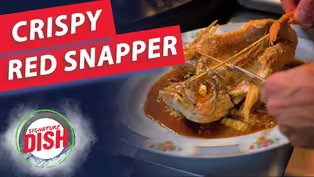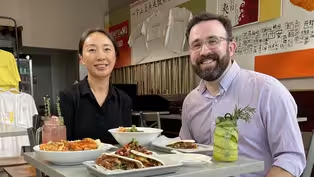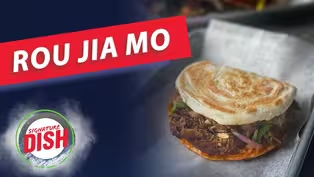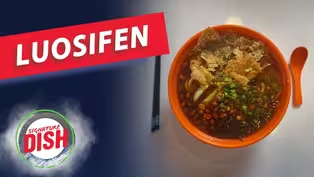Signature Dish
Flavors of China
Season 2 Episode 8 | 27mVideo has Closed Captions
Host Seth Tillman takes a flavorful journey through Chinese cuisine in DC, MD and VA.
Host Seth Tillman takes a flavorful journey through Chinese cuisine, beginning at Columbia Heights’ Queen’s English with a standout crispy whole red snapper. Rou jia mo (Chinese hamburger) is in the spotlight at Northwest Chinese Food in College Park, MD. The final stop is at Yanzi Noodle House in Fairfax, VA for the one-of-a-kind luosifen (noodle soup flavored with snails).
Problems playing video? | Closed Captioning Feedback
Problems playing video? | Closed Captioning Feedback
Signature Dish is a local public television program presented by WETA
Signature Dish
Flavors of China
Season 2 Episode 8 | 27mVideo has Closed Captions
Host Seth Tillman takes a flavorful journey through Chinese cuisine, beginning at Columbia Heights’ Queen’s English with a standout crispy whole red snapper. Rou jia mo (Chinese hamburger) is in the spotlight at Northwest Chinese Food in College Park, MD. The final stop is at Yanzi Noodle House in Fairfax, VA for the one-of-a-kind luosifen (noodle soup flavored with snails).
Problems playing video? | Closed Captioning Feedback
How to Watch Signature Dish
Signature Dish is available to stream on pbs.org and the free PBS App, available on iPhone, Apple TV, Android TV, Android smartphones, Amazon Fire TV, Amazon Fire Tablet, Roku, Samsung Smart TV, and Vizio.
Providing Support for PBS.org
Learn Moreabout PBS online sponsorshipANNOUNCER: And now Signature Dish, a WETA original series.
SETH: Today on Signature Dish, we're off on a Chinese culinary adventure.
We'll get things going hot and fast...
Chef, is it just me or is this just an absolutely enormous wok?
HENJI: This is a massive wok, and also with massive firepower.
SETH: Enjoy a twist on a familiar favorite... SETH: Chinese burger, alright.
HUA: Yeah.
SETH: Well, I love any kind of burger.
And finish off with a dish that's truly one of a kind.
Time for the snails?
All right, all right.
AUDREY: Yes, yes.
SETH: Ooh.
Okay, well that is like nothing I've ever tried before.
I'm Seth Tillman, WETA producer and DC native, and I love good food.
That's why I'm traveling to restaurants across the DMV, at each stop looking for the one thing you just got to try, that Signature Dish.
First on my itinerary is a visit to Columbia Heights.
I'm checking out Queen's English, a restaurant named for Hong Kong's century and a half run as a British colony.
The small, intimate space evokes the bygone Supper clubs once popular in Hong Kong.
SARAH: We met in New York uh, a number of years ago.
Ever since we met, I think we always wanted to open up a restaurant and it morphed into representing like, where he grew up in Hong Kong and our experiences working in New York.
HENJI: Hong Kong is very unique as far as, uh, the food culture is.
One, being an island, you know, a port city with heavily European influence, all the spices, all the trade.
And not even just in food, but in the financial world, the diamond trade, the gold trade, all that passed through Hong Kong.
And people leave little breadcrumbs or flavor along the way.
SARAH: Well, I always describe our cuisine as, it's not about spice, it's more about, like, texture.
Our holy trinity is ginger, garlic, scallion.
So the way that he's introduced those ingredients with other international ingredients is really unique.
SETH: At the restaurant, Chef Henji's cooking is on full display.
HENJI: Most restaurants with open kitchen is very quiet, it's very calm.
With the wok, it's not, you know, it's loud.
You're sitting right at the bar, you can feel the heat from the wok.
SARAH: It's controlled chaos.
We have, you know, a lot of staff working in a tight environment.
We also have a lot of guests in the room, creates a lot of energy in the room.
So it's definitely a party in here every night.
Also, Hong Kong is not a peaceful place, you know.
There's a lot going on.
There's a lot of people.
So I think it fits.
HENJI: We lean into the chaos.
♪ ♪ SETH: Chef.
HENJI: Welcome to Queen's English.
SETH: Thank you so much for having me.
I'm really excited to be here today.
What are you cooking?
HENJI: Today we're going to do a crispy red snapper, whole red snapper, with a Hong Kong chili sauce.
It's our play on a classic Cantonese steamed fish but with a modern twist to it.
We're going to start by just getting our salad ready.
That's going to be our garnish and it'll also lighten up the fish because it is a crispy fried fish.
We have a little mixed greens here, very simple.
We have a Thai basil, just some little herb freshness that goes in there.
And some shaved fennel, which gives a little crispy texture.
Little Maldon salt, little fresh ground pepper, and some extra virgin olive oil.
And that is the salad and garnish for the fish.
We're going to put that to side and now we're going to focus our attention to the red snapper.
SETH: All right.
And I feel like every time I get whole fish, whether it's fried, steamed, 90% of the time it's red snapper.
Why does it work so well?
HENJI: Snapper, it's just a great frying fish.
It's not too fatty, it's not too lean, you know.
It just has the right amount of meat and fat where it just fries up really well.
Our fish, our red snapper here, is completely de-boned.
We take all the bones out down the middle.
We leave the spine bone on just for presentation and for ease of frying.
SETH: I was going to say, it's going to make it a lot easier to eat when we're at the table.
HENJI: It is.
SETH: I think a lot of times people are just intimidated, myself included when you have to navigate all the uh, all the bones on the inside.
HENJI: Correct.
So that's typically in Cantonese cuisine, we eat our fish whole on the bone, you know, we steam it whole.
Obviously, it's a little bit different restaurant here, so it de-bone it.
It makes it easy for our guests.
Honestly, it makes it easy for our staff so they don't have to clean up the mess.
So we put the skewer across the fish and then we put another one through the tail into the head.
So this does two things.
One, for the obvious, is the presentation, and two, it fries evenly since if it wasn't skewered, it's just too thick of a fish and the insides raw, the outside's cooked, and then you wind up with a dry piece of snapper.
SETH: Well, we definitely don't want that.
So no batter, just breading?
HENJI: No batter, just breading.
In here, we've got rice flour, cornstarch, cumin, garlic, and onion powder.
We want the coating to be light because we still want the skin and the fins to get crispy.
You know, one of the greatest thing about this dish for me personally is eat the tail.
SETH: Eat the tail?
HENJI: All the spice, all the crunch on the tail is like the best Ruffle potato chips you ever have.
SETH: I'm ready to try it.
HENJI: So we have the spice mix on, so when you grab that salad, I'll grab this fish, we'll head over to the fire and we'll finish this dish.
SETH: Let's do it.
All right.
Chef, is it just me or is this just an absolutely enormous wok?
HENJI: This is a massive wok, and also with massive firepower.
A normal stove is about 20,000 BTU.
We have 175,000 BTU here.
SETH: Oh my goodness.
And what do you get with all that extra power?
HENJI: So in Cantonese cuisine, we have something called wok hei or the breath of the dragon.
So with all that firepower, that will give us the true breath of the dragon.
SETH: All that hot, fast cooking is going to also help with the texture, get a nice little char on the outside of everything?
HENJI: Correct.
SETH: So you're going to get this thing fired up?
HENJI: Yeah.
So we're going to start.
So simply, we just put the fish in the fryer.
We hold it down and start our timer.
While the fish is frying, we're going to turn on the wok, get it hot, add our oil.
So now the wok is smoking.
We're going to add in our Napa cabbage and add in our garlic.
You can feel the heat already.
And we're just going to roast that a little bit.
The good thing about the wok is because it's such high heat, you get a good char without overcooking the vegetable.
So we're going to lower the flame a little bit.
This is where we add in our sauce.
So this is our Hong Kong chili sauce.
It's got lemongrass, red bell pepper.
We do a ginger and garlic gastrique.
We add our sesame oil, confit garlic back in there.
And that's the sauce.
SETH: You can't even see what's happening in this thing, there's so much steam.
HENJI: You can't.
You kind of just got to listen to the sizzle.
SETH: Just pure muscle memory from doing this.
HENJI: Pure muscle memory, just by sound and smell.
The crab butter goes in so that gives a little bit of richness to the sauce.
(beeping) SETH: All right, timer went off.
That was fast.
HENJI: Timer went off.
Yep.
We drain off the excess oil.
We lay the fish on the tray.
We're going to leave the fish there.
We're going to grab our plate.
We're going to put the sauce on the plate, and then we're going to put the fish on top of that.
SETH: So the fish will stay nice and crispy?
HENJI: Correct.
SETH: All right.
I like that.
HENJI: Now we just make sure our salad is nice and dressed and tossed one more time.
We're going to garnish it with the salad.
And here is our crispy red snapper.
SETH: Chef, that was a spectacular cooking process and a spectacular-looking dish.
I can't wait to try it.
HENJI: I can't wait for us to eat it as well.
SETH: All right, the whole fish, salad on top.
What's the best plan of attack?
SARAH: I would take all the salad, put it to the side, get to the good stuff.
The fish is mostly deboned, but the tail and the two fins on the side, you're definitely going to want to put to the side and enjoy it at the very last.
SETH: All right, I'm going to start with... SARAH: With your chips.
SETH: Just a little bit of meat right here.
And I have to ask, what pairs nicely with this beautiful crispy red snapper?
SARAH: Honestly, I think the perfect pairing is The Queen.
It's an orange wine that we make with a friend of ours, Kim McPherson in West Texas.
SETH: This is an orange wine?
SARAH: It's an orange wine.
It's two weeks on the skin.
It just has this really fun, pineapple kind of like, peach fruity flavor.
Nothing nuanced, so it definitely holds up to all the flavor in the sauce.
SETH: Cheers to that.
SARAH: Cheers.
HENJI: Cheers.
SETH: Nice and refreshing.
SARAH: Yes.
SETH: All right, I'm digging in here.
Mmm.
Wow.
That is exquisite.
That fish is so flaky and tender.
Everything balances so nicely.
I'm going to try it with a salad as well.
Still getting that crispiness and crunchiness from the cabbage, some of that lightness from the salad.
And the sauce, I just can't get enough of that sauce.
HENJI: Yeah, that's definitely the best part of the dish.
SETH: And this is a traditional Hong Kong-style chili sauce?
HENJI: It's definitely our interpretation of it.
It's uh, it's more like a play between a sweet chili and a spicy chili sauce where it's kind of in the middle.
SETH: So it kind of goes to that idea of just sort of whatever works, you know, you're not uh, bound by any specific traditions?
HENJI: No, not really.
It's uh, the foundation of the cuisine is always Cantonese flavor profile.
But besides that, you know, we just have fun cooking what we like to cook.
SETH: Well, it's clearly a lot of fun.
I can imagine on a nightly basis, that's quite a show that you're putting on in there.
SARAH: Oh, yeah.
The chef's counter seats are in high demand and everyone wants to sit there.
It's dinner and a show.
Chaos, loud, hot, action-packed.
SETH: The way a restaurant kitchen should be.
SARAH: Yes, absolutely.
SETH: And I haven't forgotten, Henji, that you told me I have to try this tail.
HENJI: You've got to try the tail.
SETH: All right, so you know what?
I've eaten a lot of whole fish in my day.
I've eaten the fish head, the cheeks.
I've never eaten a fishtail before.
What am I in for here?
HENJI: It's the crispiest, spiciest piece of Ruffle chip you ever have.
What do you think?
SETH: That is an unexpected treat.
Never would've thought to try that.
If you hadn't told me, I would've left that tail on and not meant any offense by it.
But I'm really glad you did.
I'm definitely going to be looking for that next time.
Thank you guys.
HENJI: Thank you.
Thank you.
SARAH: Thank you.
♪ ♪ SETH: Across the DC line in College Park.
Just off Maryland's sprawling campus, I'm hitting up Northwest Chinese Food.
The restaurant, which is a hit with Terps and foodies alike is helmed by chef and owner Hua Wang.
Although Hua hails from Shenyang in China's northeast, she fell in love with the food of Xi'An, a city in China's northwest and the starting point of the historic Silk Road.
The city is home to the famed terracotta army and boasts a cuisine all its own.
SETH: Hua, nice to meet you.
SETH: Thank you so much for welcoming me here.
Oh, wow.
Some wonderful aroma coming from the stewed meat here.
What are you making today?
SETH: Rou Jia Mo, that's new for me.
What is that?
SETH: The Chinese burger?
All right.
HUA: Yeah.
SETH: Well, I love any kind of burger.
So it looks like this is going to be the meat.
Is this going to be the buns right here?
SETH: And what goes into the dough?
SETH: So you make a little tower?
HUA: Like the tower, yeah.
SETH: It's like pottery.
It's like little cups.
HUA: Yeah.
SETH: And how many of these burgers are you making every day?
SETH: Oh, wow.
HUA: Yeah.
SETH: Popular item.
HUA: Yeah, very popular.
SETH: And this is something that you're really only going to find in the northwest part of China?
HUA: Yeah.
Yeah.
SETH: Oh, the signature.
SETH: All right, so this machine looks like it means business.
HUA: Yeah, yeah, yeah.
SETH: It looks hot.
SETH: You're looking for tiger color?
HUA: Yeah, tiger color.
SETH: All right.
HUA: So you must do that.
SETH: Can't be scared of the heat.
HUA: Yeah.
It's very hot.
SETH: Oh, of course, of course.
HUA: Okay.
Yeah, yeah.
SETH: All right.
So many beautiful uh, colors and ingredients here.
HUA: Yeah, exactly, everything.
SETH: Spicy oil?
Okay.
Of course.
SETH: So how do you put this part together?
SETH: This is beef, correct?
SETH: And how long has this meat been cooking for?
HUA: This... SETH: Just falling apart, I love that.
HUA: Yeah.
And then I cut, chop this.
SETH: My mouth is watering, just looking at this.
SETH: Oh, wow.
SETH: The buns are ready?
Okay.
Oh, nice color on the top.
HUA: Smell this.
SETH: Oh, wow.
Yeah.
There is just nothing better than the smell of freshly baked bread.
HUA: See?
Look.
SETH: Almost looks like a pita.
SETH: Also beautiful color on that oil.
HUA: Beautiful.
Yeah.
SETH: That is beautiful.
Northwest Chinese actually offers up eight different versions of the Rou Jia Mo.
So before we sit down to eat, Hua prepares two more for me to sample.
All right, Chef, my first Chinese burger.
I'm excited to try this.
SETH: I am very hungry.
Wow.
HUA: How you feel?
SETH: Oh, absolutely.
HUA: Yeah.
SETH: But the way it contrasts with how tender the meat is, how nicely stewed it is, that's great.
I love the addition of the onions and the jalapeños because it gives you the extra little sort of vibrant crunch along with that stewed meat.
I've got to go in for another bite of that.
Well, I had to go back and get a little more chili oil too on that bite.
And you have a couple other types of the burger as well?
HUA: Uh-huh, yes.
SETH: Oh, nice.
SETH: Yeah, no spice on that but so many other good textures happening there.
HUA: Yeah.
SETH: And Hua, tell me about these other beautiful dishes on the table, as well.
SETH: Oh, wow.
Oh, yeah, there is definitely, definitely a nice sour flavor to that... HUA: Yeah.
SETH: Along with the heat.
SETH: All right.
My chopstick skills need a little bit of work.
It's a lifelong journey for me.
Everything, you know, from the cold noodles, the hot, the spicy, the sour, this dynamite burger, there's so many different flavors at play here.
HUA: Yeah, yeah.
SETH: It feels like this restaurant is just a really personal expression for you.
HUA: Yeah, yeah.
SETH: Love that.
Thank you so much for sharing this with me.
I really appreciate it.
HUA: Yeah, thank you.
♪ ♪ SETH: I'm wrapping things up out west in Fairfax.
In a small strip mall at the corner of Fairfax Boulevard and Main Street, is Yanzi Noodle House.
Although the menu is long, one dish stands out among the rest.
Luosifen, a rice noodle soup in a snail-flavored broth originated in Liuzhou, a city in southern China.
The Liujiang River that flows through the city has an abundance of fresh river snails.
(chatter) SETH: During the pandemic, the popularity of Luosifen exploded across China, with people making packaged versions of the famously pungent and sour soup and sharing their culinary exploits on Chinese social media.
SETH: Audrey, nice to meet you.
AUDREY: Nice to meet you.
SETH: I'm excited about a big old bowl of snails.
That's definitely a first for this show.
What are you making today?
SETH: I've heard about this dish.
But these aren't the kind of snails that you see after like, a big rainstorm?
SETH: And so how do you get these ready for cooking?
SETH: All right, well, a snail soup, I'm game.
I want to try it.
So you're going to cook these up before they go in the broth?
SETH: All right.
Let's do it.
AUDREY: Okay.
Ah, it's heavy here.
SETH: That's a lot of snails.
AUDREY: Okay.
Yes.
SETH: This wok is no joke.
AUDREY: Yeah.
SETH: And there are so many ingredients that you're gonna need for the soup as well.
AUDREY: Yes.
SETH: Sugar?
All right.
AUDREY: Yeah.
So how do you think?
SETH: I can definitely pick up a little sour flavor there.
AUDREY: All right.
SETH: Oh, time for the snails?
All right.
AUDREY: Yes, yes, yes.
SETH: That is just a mountain of snails.
SETH: Of course.
AUDREY: Yes.
SETH: After Audrey mixes in the snails, the ingredient train rolls on.
♪ ♪ Now I think I understand why people make this out of a mix because there are so many steps and ingredients in this process.
AUDREY: Yes, yes.
SETH: Oh, it does.
It looks amazing.
After the snails are finished cooking, Audrey adds them to a pot which has beef and pork bones that have been simmering into a stock for over eight hours.
Once they're added, the stock will cook for an additional two hours.
While some of the cooked snails are reserved for other dishes, there are no actual snails in the Luosifen, just the flavor.
To finish the dish, Audrey first steams bok choy and boils rice noodles.
She then garnishes the bowl with an array of vegetables and toppings, including more sour bamboo, and finally ladles on the snail soup.
All right.
Audrey, I am so excited to try this Luosifen, a dish I've never had.
I'm going to start with a broth first.
AUDREY: Okay.
SETH: See if I can get some of that snail flavor.
AUDREY: Yes.
SETH: Ooh, okay.
Well, that is like nothing I've ever tried before.
That is completely new to me, that flavor, obviously with the snails.
But there's a real complexity to it too, because you get a little sweetness, definitely a little bit of spiciness as well, and that sourness.
It's just such a nice balanced soup.
AUDREY: Thank you so much.
SETH: And these peanuts as well, got to get a little crunch in there.
I think I understand the hype now.
AUDREY: Okay.
SETH: I know why this is spreading all through China.
And of course, there's some noodles hidden down here as well, right?
SETH: Then tell me about these sauces here as well.
AUDREY: Okay.
SETH: People want to take this vinegar to go.
AUDREY: Yes, yes.
SETH: All right.
I'll go with three spoonfuls then.
Why not?
AUDREY: Okay.
Yes.
SETH: There is a little bit of heat from the broth, but the vinegar almost kind of helps sort of smooth that out a little bit.
SETH: And tell me about these little crunchy bits over here as well.
SETH: I like that the broth is unique, but that as well, the toppings, the bamboo shoots, the peanuts, and then the tofu skin, so many different textures at play there.
SETH: So what's it been like for you to have this soup that has so much meaning, goes so far back for you and your family, to be able to introduce it to all these customers in Northern Virginia who've never tried it?
SETH: Well, I hope more and more people will come out here to try this.
If they can get over any discomfort they have about snails, which I think they should, it's definitely worth trying.
So thank you so much, Audrey.
I really appreciate it.
(music plays through credits).
♪ ♪ ANNOUNCER: To find out more about great food in the Washington Metro area, visit weta.org/signaturedish.
How Queen's English Puts a Twist on a Cantonese Red Snapper
Video has Closed Captions
Clip: S2 Ep8 | 6m 40s | A standout crispy whole red snapper at Queen’s English in Columbia Heights. (6m 40s)
Preview: S2 Ep8 | 30s | Host Seth Tillman takes a flavorful journey through Chinese cuisine in DC, MD and VA. (30s)
Rou Jia Mo -- a Chinese Burger -- at Northwest Chinese Food
Video has Closed Captions
Clip: S2 Ep8 | 5m 55s | Rou jia mo (Chinese hamburger) at Northwest Chinese Food in College Park, MD. (5m 55s)
Snail-Flavored Chinese Noodles at Yanzi Noodle House
Video has Closed Captions
Clip: S2 Ep8 | 5m 11s | A noodle soup flavored with snails at Yanzi Noodle House in Fairfax, VA. (5m 11s)
Providing Support for PBS.org
Learn Moreabout PBS online sponsorship
- Food
Lidia Celebrates America
Lidia Bastianich honors America’s volunteers, revealing how giving back unites and uplifts.













Support for PBS provided by:
Signature Dish is a local public television program presented by WETA




